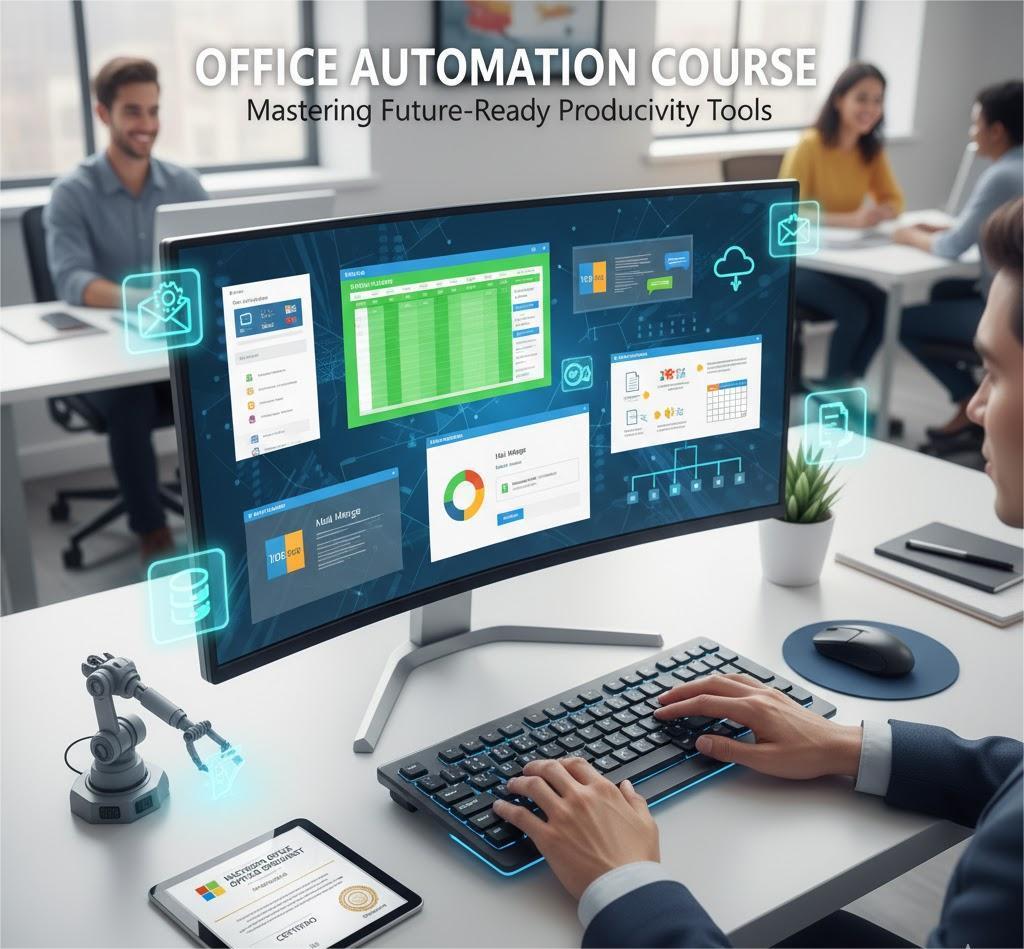
Office Automation Course: The Ultimate Guide for Students Looking to Build Future-Ready Skills
Introduction
If you’ve ever watched someone glide through spreadsheets, reports, schedules, and digital dashboards like they were born with a keyboard in their hand, you’ve probably thought, “How do they make it look so easy?” The secret usually isn’t talent. It’s office automation. Today’s workplaces run on tools that help people work faster, smarter, and with fewer mistakes. And the people who know how to use these tools become the go-to problem solvers in almost every department.
For students preparing for internships, part-time jobs, or full-time roles, learning office automation has become as essential as knowing how to write an email. It’s no longer “nice to have” it’s a core skill employers expect. Whether you want to work in marketing, finance, healthcare, IT, HR, project management, or even run your own small business, an Office Automation Course gives you the foundation you need.
This guide walks you through everything: what an office automation course includes, why it matters, how it boosts your employability, what tools you’ll learn, and how students can apply these skills in real-world scenarios. Backed by research, expert insights, and practical examples, this is your complete roadmap to mastering office automation in 2025 and beyond.
What Is an Office Automation Course?
An office automation course teaches students how to use digital tools to streamline everyday tasks like communication, data management, document creation, reporting, scheduling, and workflow coordination. These courses usually cover:
-
Word processing
-
Spreadsheets
-
Presentations
-
Databases
-
Digital communication tools
-
Cloud collaboration
-
Basic automation
Initially designed for secretarial and administrative roles, these courses have evolved into technical learning programs for nearly every profession. With workplaces shifting toward digital-by-default systems, office automation is now a universal skill.
Why Office Automation Skills Matter for Students in 2025
1. Employers Expect Technology Literacy
A 2024 LinkedIn Workforce Report noted that 72 percent of entry-level job postings require proficiency in office software. Students who can only use basic word processors fall behind those who can analyze data, create structured reports, and collaborate in cloud environments.
2. Automation is Reshaping Modern Jobs
McKinsey & Company projects that by 2030, more than 30 percent of repetitive administrative tasks will be automated. But automation doesn’t eliminate jobs it shifts responsibility toward monitoring, optimizing, and managing digital tools. Students trained in these skills stand out.
3. Increases Productivity (and Reduces Stress)
Students juggling assignments, internships, and early career responsibilities often get overwhelmed. Office automation simplifies tasks like:
-
Organizing research data
-
Creating reports
-
Scheduling
-
Compiling information
-
Preparing presentations
Learning these skills early reduces frustration and builds confidence.
Core Modules in a Modern Office Automation Course
Below is a breakdown of what a high-quality course typically teaches, along with real-world applications to help students make sense of each tool.
1. Word Processing and Document Management
Tools covered: Microsoft Word, Google Docs, LibreOffice Writer
Students learn to:
-
Format academic and workplace documents
-
Use templates for reports, resumes, and proposals
-
Apply referencing and citations intelligently
-
Insert tables, charts, and page designs
-
Use advanced features like mail merge
Real-world student example:
A student interning in HR may need to create onboarding packets. Knowing how to design clean, consistent documents builds professionalism and reduces mistakes.
2. Spreadsheet Mastery (A Must-Have Skill Today)
Tools covered: Microsoft Excel, Google Sheets
One of the most valued workplace skills today is spreadsheet literacy. Students learn:
-
Basic formulas (SUM, AVERAGE, COUNT)
-
Intermediate functions (VLOOKUP, XLOOKUP, INDEX/MATCH)
-
Pivot tables
-
Charts and dashboards
-
Data cleaning with filters and conditional formatting
-
Automating repetitive tasks
Case study:
A marketing student can use spreadsheets to track campaign performance or analyze customer survey data. Recruiters love students who can turn numbers into insights.
3. Presentation Design and Visual Communication
Tools covered: PowerPoint, Google Slides, Canva
Students learn how to:
-
Create engaging slides
-
Use storytelling structure
-
Add charts, transitions, and multimedia
-
Design polished academic and professional presentations
Insight:
According to the National Association of Colleges and Employers (NACE), presentation skills are in the top 6 competencies employers seek.
4. Database Basics
Tools covered: MS Access, Airtable, Notion databases, Google Tables
What students learn:
-
Create and manage tables
-
Understand relationships between data
-
Build simple forms and queries
-
Automate data organization
Example:
A business student creating a product catalog or an inventory system can use a basic database to organize information efficiently.
5. Digital Collaboration & Cloud Tools
Tools covered: Google Workspace, Microsoft 365, Slack, Teams, Zoom
Students learn:
-
Real-time document collaboration
-
Task management
-
Version control
-
Team communication
Real-world value:
Interns who know how to use Google Workspace or Teams effectively integrate faster into remote or hybrid workplaces.
6. Introduction to Workflow Automation
Tools covered: Zapier, Power Automate, IFTTT, Google Workspace automations
Students learn to automate tasks such as:
-
Sending automated email updates
-
Creating data pipelines
-
Auto-filling spreadsheets
-
Moving files between platforms
Professional advantage:
Knowing how to automate even simple workflows makes students appear resourceful and tech-savvy — a valuable trait in fast-paced environments.
Who Should Take an Office Automation Course?
While the course is useful for everyone, the following students benefit most:
-
Business and commerce students
-
Marketing majors
-
Accounting and finance learners
-
Computer science beginners
-
Healthcare administration students
-
HR, operations, and management students
-
Freelancers and student entrepreneurs
Even if your major isn't tech-heavy, you will still use these tools in nearly every internship and job.
How Office Automation Skills Boost Employability
Office automation training directly increases a student’s career opportunities. Here’s how:
1. You Stand Out in Job Applications
Employers use Applicant Tracking Systems (ATS) to screen resumes. Students who list specific office tools and certifications rank higher automatically.
2. You Become the “Problem Solver” Intern
Teams love interns who can:
-
Fix formatting issues
-
Organize data
-
Create dashboards
-
Improve processes
These contributions make a strong impression.
3. You Qualify for More Roles
An office automation background opens doors to roles like:
-
Administrative assistant
-
Data entry specialist
-
Marketing assistant
-
Project coordinator
-
HR assistant
-
Customer support analyst
-
Junior data analyst
-
Operations associate
4. You Work Faster and With More Accuracy
Automation reduces manual errors. In industries like finance, healthcare, and research, precision matters.
How to Choose the Right Office Automation Course
Here’s a simple framework for students:
1. Look for Practical, Project-Based Learning
Ensure the course includes real-world assignments, not just theory.
2. Check for Updated Tools
Avoid outdated courses using old versions of Excel or Word.
3. Ask About Certifications
Microsoft Office Specialist (MOS) certificates can significantly boost resumes.
4. Choose Courses With Live Instructor Support
This helps with troubleshooting, especially for spreadsheet and automation modules.
5. Read Reviews From Previous Students
Pay attention to feedback about pace, instructor clarity, and practical examples.
Practical Ways Students Can Apply Office Automation Skills
Here are examples that bring the skills to life:
-
Create a GPA calculator spreadsheet.
-
Build a budget tracker.
-
Make a resume template in Word.
-
Set up a project tracker using Google Sheets.
-
Create a digital filing system for your assignments.
-
Automate reminders for deadlines.
-
Build a class presentation deck with consistent branding.
These small projects form a strong portfolio for internships.
FAQs (People Also Ask Style)
1. Is an office automation course hard?
Not usually. Most courses start with beginner-friendly lessons. Students with basic computer knowledge can learn quickly.
2. How long does it take to complete an office automation course?
Most courses take 4–12 weeks depending on depth.
3. Is office automation useful for non-technical students?
Absolutely. Whether you're studying arts, business, medicine, or IT, you will need digital productivity skills.
4. Do employers really care about office automation skills?
Yes. Employers consistently list digital tool proficiency among the top desired skills for entry-level roles.
5. Can office automation help me in college?
Yes from creating assignments to managing schedules to analyzing data, you’ll use these tools daily.
Tags :
No Tags












0 Comments